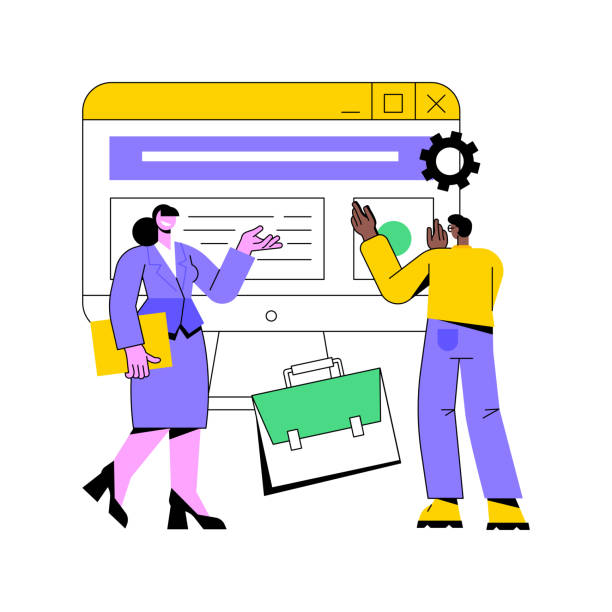Introduction to the Importance of E-commerce Website Design in the Digital Age
![]()
In today’s world, where physical trade borders have been removed by the internet, e-commerce website design is no longer a competitive advantage, but an undeniable necessity for every business.
From small and local businesses to large and international brands, all have realized that an active online presence and offering products or services through an #efficient_e-commerce_website is key to reaching wider markets and increasing market share.
This digital transformation has created countless opportunities for #online_income and sustainable growth.
The importance of this issue is not limited to gaining access to more customers; rather, it includes providing a unique shopping experience, 24-hour access, and reducing operational costs.
This section, as an explanatory and educational text, examines why e-commerce website design is vital in the ecosystem of modern businesses and shows you how an online platform can transform the fate of your business.
Having a powerful e-commerce website allows you to introduce your products to thousands of potential customers worldwide, without geographical and time limitations, and significantly increase your sales.
E-commerce is the backbone of the digital economy, and e-commerce website design is the first step on this fast-paced path.
This trend has accelerated, especially in the post-pandemic era, highlighting the necessity of online presence more than ever.
Therefore, if you intend to enter this field, you must take firm steps with a deep understanding of the importance of e-commerce website design.
Are you dissatisfied with the low conversion rate of visitors to customers on your e-commerce site?
Solve this problem forever with professional e-commerce website design by Rasaweb!
✅ Increase visitor-to-customer conversion rate
✅ Create an excellent user experience and build customer trust
⚡ Get free consultation
First Steps in E-commerce Website Design: Choosing the Right Platform
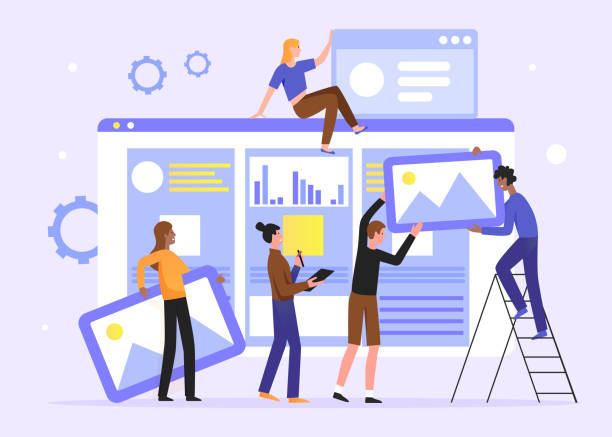
After understanding the importance of online presence, it’s time to choose the right infrastructure and platform for your e-commerce website design.
This stage is one of the most vital decisions that will directly impact your site’s scalability, security, costs, and ease of management in the future.
There are numerous options in the market, each with its own advantages and disadvantages.
Open-source platforms like WooCommerce, an add-on for WordPress, or Magento, offer high flexibility for customization but require more technical knowledge for setup and maintenance.
In contrast, SaaS (Software as a Service) platforms like Shopify are ideal options for those with less technical knowledge, offering simplicity and high setup speed, although they might incur higher costs in the long run and have more limited customization options.
Guidance in choosing the right platform should be based on your specific business needs, available budget, product and service volume, and long-term growth plans.
A wrong choice at this stage can lead to serious problems in the future and necessitate a complete site rebuild, which would entail significant costs.
This section expertly compares these platforms and helps you choose the best option for your e-commerce website design with a clearer perspective.
Important factors such as ease of use, SEO features, payment options, and technical support are among the items that should be carefully considered at this stage.
Without the right choice, even the best ideas for e-commerce website design may not come to fruition.
Choosing a platform that aligns well with your business needs is of paramount importance.
Key Elements in Designing the User Interface and User Experience of a Successful E-commerce Website
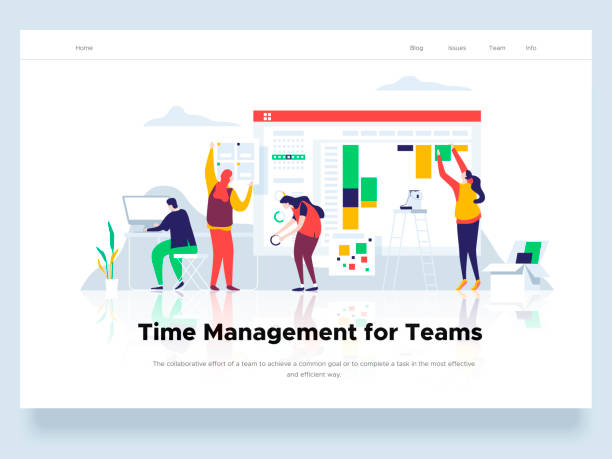
The success of an e-commerce website goes far beyond merely listing products for sale; it deeply depends on how the user experiences interacting with the site.
User Interface (UI) design and User Experience (UX) are two main pillars that determine the quality of an e-commerce website.
An attractive and visual user interface, coupled with a smooth and hassle-free user experience, encourages customers to stay, browse, and ultimately make a purchase.
This section analytically and explanatorily examines these key elements.
Simple and logical navigation, high loading speed, responsive design for correct display on all devices (mobile, tablet, desktop), and rich product pages with high-quality images and complete descriptions, are all components of an excellent user experience.
Also, the checkout process should be as simple and fast as possible to prevent customers from abandoning their carts.
The better the user experience, the higher the likelihood of customer return and loyalty.
In e-commerce website design, it is necessary to look at everything from the user’s perspective and ensure that the purchase path, from entry to order completion, is frictionless.
Proper use of white space, readable fonts, and pleasant color schemes also significantly contribute to UI improvement.
This e-commerce website design should be such that even less experienced users can easily use it.
| UI/UX Element | Description and Importance | Impact on Conversion Rate |
|---|---|---|
| Easy and Intuitive Navigation | Users should be able to quickly find desired products and easily move between different pages. | Significant Increase |
| Responsive Design (Mobile-Friendly) | Correct display and consistent user experience across various devices (mobile, tablet, desktop). | Mandatory and Critical |
| High Loading Speed | Pages must load quickly to prevent users from leaving due to waiting. | Decrease if slow |
| Rich Product Page | High-quality images, complete descriptions, user reviews, and relevant information. | Increased Trust and Purchase |
| Simple Payment Process | Fewer and transparent steps to complete a purchase, along with diverse payment options. | Reduced Cart Abandonment |
Security and Payment Gateways in E-commerce Website Design

One of the most significant concerns for users when shopping online is the security of their personal and financial information.
Therefore, in e-commerce website design, ensuring security must be a top priority.
Using an SSL (HTTPS) certificate for data encryption is the first and most fundamental step.
This certificate not only protects information from eavesdropping and tampering but also sends a positive signal to search engines and aids the site’s SEO.
In addition to SSL, choosing secure and reputable payment gateways is also crucial.
In Iran, payment gateways from accredited banks and payment service providers are the primary options.
Each of these gateways has its own specific security protocols that must be carefully reviewed and implemented.
This section expertly and informatively addresses the importance of these points and provides practical solutions for enhancing security in e-commerce website design.
Other security measures include using strong firewalls, regular software updates for the site, and regular data backups.
Neglecting security can lead to loss of customer trust, damage to brand reputation, and even heavy financial losses.
An e-commerce site with excellent design but weak security can never survive in a competitive market.
E-commerce website design with the highest security standards means creating a trustworthy platform for customers.
This not only helps protect customer information but also increases their sense of confidence and satisfaction.
Ensuring transaction security and protecting customer information is the main pillar of any successful online business.
Without this trust, no buyer will be willing to make a transaction.
Are you tired of your company’s website not meeting your expectations? With Rasaweb, design a professional website that truly represents your business.
✅ Increase attraction of new customers and sales leads
✅ Boost your brand’s credibility and trust among your audience
⚡ Get a free website design consultation!
SEO for E-commerce Websites: How to Attract Customers?
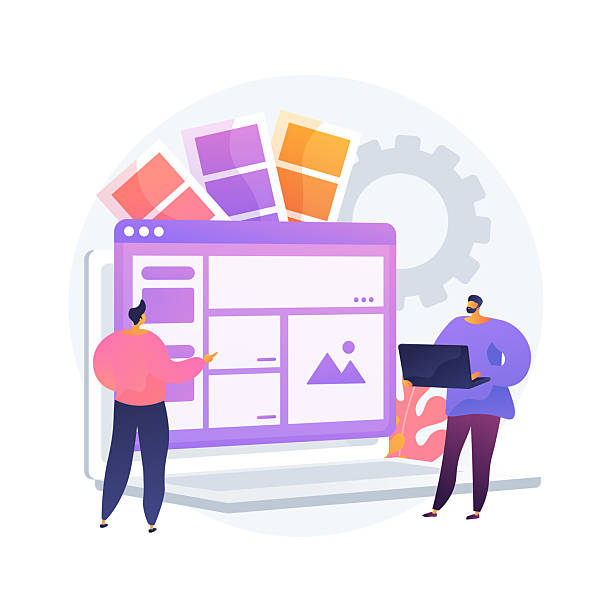
Having a beautiful and secure e-commerce website is only half the battle; for true success, you must ensure that potential customers can find you.
This is where Search Engine Optimization (SEO) comes into play.
SEO for e-commerce sites is slightly different from content-based websites and requires a specialized approach.
From keyword research for products and categories to optimizing product descriptions, page titles, and meta descriptions, everything must be done carefully.
The educational nature of this section helps you become familiar with SEO principles and techniques that are vital for e-commerce website design.
One important point is to create unique and rich content for each product page; copying descriptions from manufacturers or competitors will harm your site’s SEO.
Also, a strong internal linking structure, using Schema Markup for better display of information in search results (such as price, availability, and reviews), and optimizing product images are other important factors.
The ultimate goal of SEO is to increase organic (free) traffic to your site, which leads to increased sales.
Comprehensive guidance in this area can help you gain a better position in competition with other online stores.
E-commerce website design without considering SEO principles is like building a beautiful shop in the desert.
Even the best products won’t be purchased if they’re not seen.
Proper implementation of SEO strategies is a long-term investment for the visibility and continuous growth of your online store.
This requires continuous analysis and updates based on changes in search algorithms.
An excellent e-commerce website design from an SEO perspective ensures long-term success.
Importance of Content and Marketing Strategies in an E-commerce Website

Alongside SEO and technical design, content and marketing strategies play a vital role in attracting and retaining customers for your e-commerce website.
Engaging and useful content can convert visitors into loyal customers.
This content includes product descriptions, high-quality images, videos, blog articles, and user reviews.
Each of these elements, whether entertaining or analytical, provides the necessary information to the customer and builds their trust.
Creating a blog related to your products is an excellent opportunity to provide educational content, answer frequently asked customer questions, and establish a reputable position in your industry.
Furthermore, digital marketing strategies such as social media marketing, email marketing, and online advertising can drive targeted traffic to your e-commerce website.
Integrating the site with social platforms allows customers to easily share products and, through word-of-mouth marketing, help attract new customers.
This section provides comprehensive guidance on the importance of these strategies in e-commerce website design and subsequently, for increasing sales and customer loyalty.
Offering attractive discounts and promotional campaigns, creating a sense of urgency in purchasing, and personalizing the shopping experience based on user behavior are other effective tactics in this area.
Success in e-commerce website design depends not only on technical aspects but also on your marketing power and storytelling.
An e-commerce website design whose content is properly managed and marketed will ultimately transform into a powerful sales machine.
This demonstrates that content and marketing are inseparable from the overall success of an online store.
Optimizing E-commerce Website Speed and Performance for Better User Experience

The loading speed of an e-commerce website not only affects SEO but is also directly linked to user experience and conversion rates.
Studies have shown that every second of delay in page loading can decrease the conversion rate by up to 7 percent.
Therefore, optimizing speed and performance is a specialized and vital aspect of e-commerce website design.
Key optimization methods include compressing images without losing quality, using a Content Delivery Network (CDN) to distribute content on servers closer to users, caching pages, and optimizing CSS and JavaScript code.
This section explains and educates on the details of these techniques.
Reducing HTTP requests and removing unnecessary scripts and plugins can also significantly boost site speed.
Tools like Google PageSpeed Insights can help you identify weaknesses and improve site performance.
This e-commerce website design should always be implemented in a way that ensures high stability and speed, even during peak traffic.
A fast site not only keeps users satisfied but also gives them more confidence to complete transactions.
E-commerce website design with a focus on speed is an investment for long-term success and increased customer loyalty.
The smoother the user experience, the more inclined customers will be to return and make repeat purchases from you.
Speed optimization is a continuous process and should be regularly reviewed and improved to ensure the site is always at its best.
High speed is one of the main components of a competitive e-commerce website.
| Optimization Technique | Explanation | Impact on Performance |
|---|---|---|
| Image Compression | Reducing the file size of images without noticeable loss of quality. | Reduces page load time |
| Using CDN | Distributing content across different geographical servers for faster loading. | Reduces Latency |
| Caching | Temporarily storing data for faster loading on subsequent visits. | Increases speed for returning users |
| Minification of Codes | Removing unnecessary characters from CSS, JS, and HTML files. | Reduces file sizes |
| Server Optimization | Choosing suitable hosting and proper server configuration. | Overall site stability and speed |
Continuous Support and Updates for E-commerce Websites: Ensuring Survival in a Competitive Market

After the completion of e-commerce website design and its launch, your work is not over.
In fact, this is just the beginning.
Continuous maintenance and updating of an e-commerce website are highly important to ensure its proper functioning, security, and survival in a competitive market.
This section, as an informative and guidance text, addresses the importance of continuous support.
Software updates (platform, plugins, themes) are essential for fixing security bugs and improving performance.
Additionally, it is necessary to regularly back up site data so that your information can be recovered in case of any issues.
24-hour or business-hour technical support assures customers that help is available if a problem arises.
Managing product inventory, updating prices, and adding new products are also among the daily tasks in maintaining an e-commerce website.
Without regular maintenance, your site will gradually become slow, insecure, and outdated.
This can lead to losing customers and decreasing sales.
E-commerce website design should be carried out considering future maintenance and update capabilities.
The importance of investing in a strong support team or hiring a specialized company, should not be overlooked.
This section expertly addresses the challenges of maintenance and its importance for sustainable growth.
Ensuring service continuity and providing the best possible customer experience, requires a commitment to continuous support and updates.
Remember that a successful e-commerce website is always evolving and improving.
Does your current e-commerce website design lead to losing customers and sales?
Rasaweb is your solution with modern and user-friendly e-commerce website designs!
✅ Significant increase in conversion rates and sales
✅ Strong branding and building customer trust
⚡ Get a free e-commerce website design consultation from Rasaweb!
Data Analysis and Reporting for E-commerce Website Growth
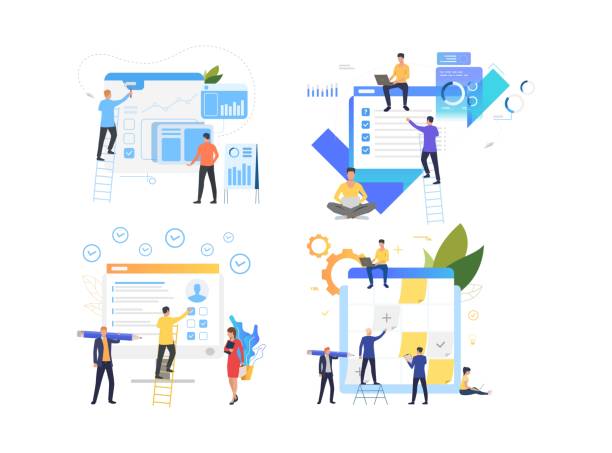
For your e-commerce website to grow and achieve your business goals, merely launching and maintaining it is not enough; you must continuously analyze its performance and make data-driven decisions.
Tools like Google Analytics provide valuable insights into user behavior, traffic sources, popular pages, and conversion rates.
This data helps you identify the strengths and weaknesses of your e-commerce website design and optimize your marketing and sales strategies.
This section educates and specializes in the importance of data analysis and how to use it for business growth.
Through data analysis, you can understand which products receive the most attention, from which channels customers arrive at your site, and at which stages of the purchase process they abandon their carts.
This information enables you to improve site performance by making changes in design, content, or pricing strategies.
Regular reporting on sales, inventory, and profitability is also essential for financial management and strategic planning.
E-commerce website design that allows for accurate data collection and analysis is a significant competitive advantage.
These insights help you make more informed decisions and use your resources more effectively.
Data analysis is an iterative process; with every change and optimization, you must re-monitor the results and receive necessary feedback.
Ultimately, e-commerce website design with a data-driven approach is a clear path to achieving sustainable success in the online world.
Challenges and Future of E-commerce Website Design in Iran and Worldwide

The world of e-commerce website design is constantly evolving and facing new challenges and opportunities.
In Iran, in addition to global challenges such as increasing competition and changes in search engine algorithms, issues like international payment restrictions, filtering and internet access, and economic fluctuations also exist, which impact e-commerce website design and its management.
This section, as a thought-provoking and specialized content, addresses these challenges and future outlook.
On the other hand, technological advancements such as Artificial Intelligence (AI) for personalizing the shopping experience, Augmented Reality (AR) and Virtual Reality (VR) for providing realistic product displays, and Blockchain for enhanced transaction security, will transform the future of e-commerce websites.
To stay at the forefront of these developments, businesses must constantly innovate and adapt to new trends.
E-commerce website design in the future should be smarter, more personalized, and more interactive.
Embracing new technologies and anticipating customer needs is key to success in this dynamic market.
Discussions around the importance of sustainability and social responsibility in e-commerce website design are also increasing.
Businesses that pay attention to these issues can gain even more customer trust and loyalty.
Ultimately, the future of e-commerce website design is moving towards creating fully immersive and integrated user experiences, where the line between online and physical shopping blurs.
Challenges are opportunities for growth, and readiness for them ensures future success.
Frequently Asked Questions
| Question | Answer |
|---|---|
| What is e-commerce website design? | E-commerce website design refers to the process of building and developing an online platform that allows users to purchase products or services online. This includes user interface design, user experience, security, shopping cart, and payment gateway. |
| Why is having an e-commerce website important for businesses? | Having an e-commerce website allows businesses to be active 24/7, expand their target market, reduce operational costs, and provide easier customer access to their products. |
| What are the most important features of a successful e-commerce website? | The most important features include excellent User Interface and User Experience (UI/UX), high loading speed, security (SSL and secure payment gateway), Responsive Design, Search Engine Optimization (SEO), and easy product and order management. |
| What is the role of SEO in e-commerce website design? | SEO helps your e-commerce website rank higher in Google and other search engine results. This increases organic visitors and ultimately, sales. |
| What is the importance of security in e-commerce websites? | Security is vital for protecting sensitive customer information (such as banking and personal data). Using an SSL certificate, secure payment gateways, and adhering to security standards builds customer trust and prevents fraud. |
| What are the common platforms for e-commerce website design? | Common platforms include WooCommerce (for WordPress), Shopify, Magento, PrestaShop, and custom development, each with its own advantages and disadvantages. |
| What does Responsive Design mean in e-commerce website design? | Responsive design means that your e-commerce website displays correctly and optimally on any device (mobile, tablet, laptop). This is crucial for user experience and SEO. |
| How can User Experience (UX) be improved on an e-commerce website? | User experience can be improved by simplifying the purchase process, providing easy navigation, attractive visual design, complete product information, customer reviews, and online support. |
| What is the role of images and product descriptions on an e-commerce website? | High-quality images and complete, accurate product descriptions help customers make better decisions and trust the product. This directly impacts the Conversion Rate. |
| What is the importance of customer support on e-commerce websites? | Strong and quick customer support increases customer satisfaction and loyalty. Providing various support channels (phone, online chat, email) and responding to questions and solving problems enhances the store’s credibility. |
And other services of Rasaweb Advertising Agency in the field of advertising
Smart Brand Identity: Revolutionize click-through rates with smart data analysis.
Smart Custom Software: A blend of creativity and technology to increase sales through smart data analysis.
Smart Brand Identity: An innovative platform for improving website traffic with Google Ads management.
Smart Marketing Automation: A dedicated service for online growth based on custom programming.
Smart Link Building: A creative platform for improving customer acquisition by optimizing key pages.
And over a hundred other services in the field of internet advertising, advertising consulting, and organizational solutions
Internet Advertising | Advertising Strategy | Advertorials
Resources
- Successful E-commerce Website Design in Iran
- Comprehensive Guide to Online Store Design
- E-commerce Site Development Services
- Success Factors in Online Store Design
✅
? For your business to shine in the digital world, Rasaweb Afarin Digital Marketing Agency, with expertise in professional website design, SEO, and comprehensive digital marketing strategies, paves your path to success.
📍 Tehran, Mirdamad Street, next to Bank Markazi, Kazeroon Jonoubi Alley, Ramin Alley, Plaque 6

